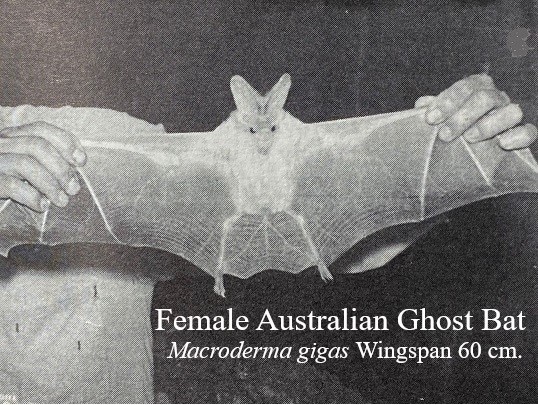Protected Magazine
Ghost Bats – The World’s 3rd Largest Microbat
This iconic animal is endemic to Australia and is our largest micro-bat with a wingspan of 60 cm! That is to say, despite its size, it is not a mega-bat, and so is not a member of the Flying Fox group. It is the world’s 3rd largest micro-bat.
Micro Bats have two different types of ultrasonic echo-location (sonar) by which they find their way around and locate and catch prey. In one version the signal is emitted through the mouth, much as we speak or cry out. These are known as vocal emissions. Although the Ghost Bat emits loud audible cries, these are not part of its echo-location system.
The Ghost Bat is a nasal emitter, so its echo-location signals come through the nostrils. Our human nearest equivalent would be to hum. So, to improve this less powerful signal, nasal emitting bats appear to have developed nose-leaves and even bigger ears to capture the returning echoes. All echo-locating bats have disproportionally larger ears than other equivalent sized mammals. But nasal emitting bats, such as the Ghost Bat have even bigger ears. The nose-leaf acts like a reflector on a car headlamp, condensing the signal and making it directional. Imagine a car lamp bulb without a reflector, with the light dispersed weakly in all directions, which would be without the benefit of a directional beam.
Those enormous ears are the receptors for echo signals. The Ghost Bats ears are so large that they are joined for about a third of their height to provide mechanical stiffening so they don’t collapse in the slipstream caused by the animal’s flight speed. Without the information input from erect ears the animal’s navigation abilities would be impaired, and likely result in unintended collisions.
From photographs of Ghost Bats in flight, it can be noticed that the head is held horizontally, even though the animal is executing a turn with the rest of its body tilted (while banking). Placing a spirit level across the tips of the ears in a correctly oriented photograph will demonstrate this behaviour. It is the sole representative of its genus Macroderma.
Worldwide there are 5 species in 3 genera in the family Megadermatidae, of which the Australian Ghost Bat is the largest.
The Ghost Bat behaves like an owl, and is an opportunistic predator. It has feeding roost stations where it can dismember prey relatively free from disturbance. Although it may hunt on moonlit nights, it avoids hunting in direct moonlight. This suggests avoidance of a sighted predator. Prey can consist of large insects, small reptiles and mammals, and small birds up to the size of an Owlet Nightjar. Detritus found below feeding roost stations, if they are in sheltered locations such as caves, can provide information on food sources. Debris lost below feeding roosts in forested sites would usually be submerged by leaf-fall.
This brilliant animal has conspicuous eyes, and it is reasonable to infer that vision plays an important role in its life. Their fur colouring can be variable and is often marked fairly conventionally with a darker back (dorsal), and a paler coloured belly (ventral), similar to a Kookaburra. Investigations by the Queensland Museum at Riversleigh, has revealed fossils of the ancestors of Ghost Bats dated to 20 million years ago.
The Mount Etna based population in central Queensland has suffered a dramatic decline, going from 150 animals in the 1980’s to a mere 40 now. I have the impression that some small populations throughout northern Australia have already disappeared, and other larger populations seem to be suffering significant reductions.
There is an urgent need to stridently address all the threatening processes, to arrest their slide to oblivion after existing here for more than 20 million years.


